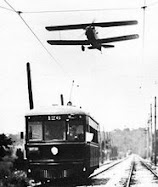Amtrak is ready to roll from Jacksonville, and just awaiting the Presidents pen.
Key Provisions of Passenger Rail Investment and Improvement Act of 2008
* Increases Capital and Operating Grants to Amtrak. The bill authorizes $4.2 billion (an average of $840 million per year) to Amtrak for capital grants and $3.0 billion (an average of $606 million per year) for operating grants. Past inconsistent Federal support has hampered Amtrak's ability to replace catenaries, passenger cars, bridges, ties, and other equipment necessary for Amtrak to provide service. These capital grants will help Amtrak bring the Northeast Corridor to a state-of-good-repair, procure new rolling stock, rehabilitate existing bridges, as well as make additional capital improvements and maintenance over its entire network. In addition, the operating grants authorized under the bill will help Amtrak pay salaries, health costs, overtime pay, fuel costs, facilities, and train maintenance and operations. These operating grants will also ensure that Amtrak can meet its obligations under its recently negotiated labor contract.
* Increases Capital and Operating Grants to Amtrak. The bill authorizes $4.2 billion (an average of $840 million per year) to Amtrak for capital grants and $3.0 billion (an average of $606 million per year) for operating grants. Past inconsistent Federal support has hampered Amtrak's ability to replace catenaries, passenger cars, bridges, ties, and other equipment necessary for Amtrak to provide service. These capital grants will help Amtrak bring the Northeast Corridor to a state-of-good-repair, procure new rolling stock, rehabilitate existing bridges, as well as make additional capital improvements and maintenance over its entire network. In addition, the operating grants authorized under the bill will help Amtrak pay salaries, health costs, overtime pay, fuel costs, facilities, and train maintenance and operations. These operating grants will also ensure that Amtrak can meet its obligations under its recently negotiated labor contract.
* Develops State Passenger Corridors. In an effort to encourage the development of new and improved intercity passenger rail services, the bill creates a new State Capital Grant program for intercity passenger rail capital projects, and based on the New Starts transit capital program administered by the Federal Transit Administration. The bill provides $2.5 billion ($500 million per year) for grants to States to pay for the capital costs of facilities and equipment necessary to provide new or improved intercity passenger rail. The Federal share of the grants is up to 80 percent. The Secretary of Transportation would award these grants on a competitive basis for projects based on economic performance, expected ridership, and other factors.
* Provides Funding for High-Speed Rail Corridors. The National Surface Transportation Policy and Revenue Study Commission, established to develop a national transportation vision to address surface transportation needs for the next 50 years, recommends that the United States establish a high-speed rail network that spans the entire country. The bill authorizes $1.75 billion ($350 million per year) for grants to States and/or Amtrak to finance the construction and equipment for 11 authorized high-speed rail corridors. The Federal share of the grants is up to 80 percent. The Secretary of Transportation would award these grants on a competitive basis for projects based on economic performance, expected ridership, and other factors.
COMMENT FROM THE NATIONAL ASSOCIATION OF RAILROAD PASSENGERS?
Four Ways to Consider Intercity Passenger Train Expansion
Wednesday, May 28, 2008
(1) Provide service to the largest metro areas currently without it. The eight largest, in descending order of population are:
*Las Vegas, NV
*Columbus, OH
*Nashville, TN
*Louisville, KY
Tulsa, OK
Allentown-Bethlehem, PA
Baton Rouge, LA
McAllen-Edinberg, TX
* Indicates Amtrak formerly provided service. Las Vegas service lasted through May 10, 1997; Columbus, Nashville and Louisville lost service at the end of October, 1979, although Louisville briefly regained service with a painfully slow train to Chicago. That train ran Chicago-Jeffersonville, IN starting December 17, 1999, was extended across the river to Louisville December 4, 2001, and discontinued July 8, 2003.
(2) Route study requests in S. 294 (which passed the Senate in October):
restore Amtrak’s Pioneer that linked Seattle-Portland with eastern Oregon, Boise and Salt Lake City. (Towards the end, its financial viability was compromised by running as a separate train all the way across Wyoming to Denver, rather than serving SLC and connecting there with the California Zephyr.)
restore Amtrak’s North Coast Hiawatha in southern Montana and southern North Dakota – well used train until its demise in 1979.
(3) Maps in the National Surface Transportation Policy & Revenue Study Commission report, at chapter four:
The 2015 vision is at page 4-22 and notably includes
Cleveland-Columbus-Cincinnati
a long-discussed Meridian-Jackson-Dallas link among existing Amtrak routes, and
closing the Bakersfield-Los Angeles gap.
The 2030 vision is on the next page and adds several routes including
Atlanta-Jacksonville Florida,
Dallas-Houston,
Oklahoma City to both Newton/Kansas City and Tulsa/St. Louis,
Cheyenne-Denver-Trinidad-Albuquerque-El Paso
the above-referenced Pioneer, and
service to Las Vegas from both east and west.
The 2050 vision is on page 4-24 and adds many more routes including Chicago-Atlanta.
The Commission recommends annual capital expenditure of $9 billion, much of which would support “genuine” high speed rail projects such that planned in California.
(4) NARP’s 40-year vision, which is more aggressive than the Commission’s although North Carolina DOT’s vision is more aggressive than ours! Read more about our Grow Trains Campaign and Vision Plan including regional “zoom-in” maps.


























No comments:
Post a Comment